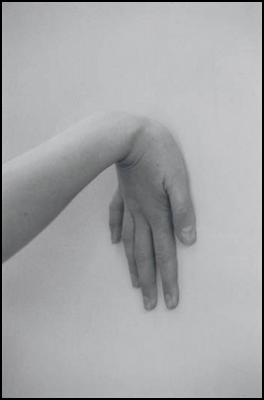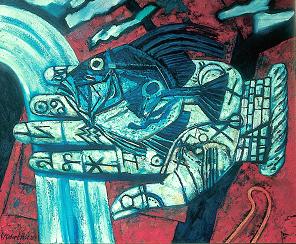The Hand as Subject - imagery of the hand

Peter Peryer, Janets Hand, 1993, vintage print on paper . Courtesy Ferner Gallery Auckland.
Media Release
AT THE WHANGAREI ART MUSEUM
7 APRIL – 25 MAY
2008
The Hand as Subject
- imagery of the
hand
BERAN ELLIS JENKINSON JESSON LANE PERYER ROBINSON SMITH STRINGER SWAN TRUSTTUM TWISS
In
association with
Mark Hutchins Gallery Wellington
James Wallace Trust Auckland,
Ferner Gallery Auckland,
the artists and works from the
Whangarei Art Museum
Collection
The Hand as an object for creative human
iconography is NOT a fresh subject for exhibition
exploration! After all it was the subject for Neolithic
society’s first pubic gallery spaces – cave paintings
more than 20,000 years ago !
Closer to our own timeframe has been “Show of Hands” the opening exhibition at the Manawatu Art Gallery in 1975 and 30 years later; “Return of the Hand; The Hand in art and culture” at the Sarjeant Gallery in 2005 which included works from the Whangarei Art Museum collection. A more recent exhibition at the Mark Hutchins Gallery in Wellington “The Language of Touch” was a further inspiration to reformulate an exhibition here to complement and compliment the late Joanna Paul’s adroit handling of her own medium of drawing, and its metaphysical and narrative impact in the tribute Subjects to Hand exhibition concurrently showing at the art museum.
The Hand as Subject is an engaging and powerful exhibition of works by nationally and internationally renowned artists Peter Peryer, Robert Jesson, Philip Trusttum, Robert Ellis, Rebecca Swan, James Robinson, Greer Twiss and Terry Stringer, Tony Lane, Megan Jenkinson and two eminent local artists Grant Beran and Ellen Smith.

Robert Ellis, Kuparu ( John Dory), 1989, oil on canvas.
Whangarei Art Museum collection.
Hand prints on cave walls made with charcoal mixed with animal fat were among the first creative images made by mankind and the Hand as symbol has had a powerful and universal resonance ever since. The hand as symbol has become the hand of blessing in religious iconography in Buddhist and Christian imagery and the upraised hand became the emblem of the Ringatu sect established by Te Kooti Rikirangi in 1886.’ Ringa Tu’ means upraised hand.
The thumbprint is synonymous with identity and has become the symbol of instant brand recognition for Te Papa. The handshake is used in greeting globally and the hand icon is universally understood for scrolling text on pc’s and mobile phones. It is also a globally accepted signal to stop, at traffic lights and pedestrian crossings. The Hand works so elementally because it is both primal in its power AND because it is sophisticated in its layers of meaning to humans across the planet. Conceptually the word ‘hand’ has associative power too as it implies touch, and feeling and the concept of ‘hand-made’ in a processed world.
The Arts and Crafts movement of the 1880’s and the later Omega Workshop of the early 20th century among similar arts movements internationally raised the status of handiwork and artisanship as a counterpoint to the Industrial Revolution and mass production; making the concepts of handcrafting and the tactile as relevant today, in a world of text speak and high volume consumerism as they were in the Victorian era. The Hand is as emblematic and telling in its power today, as it was then.
The exhibition in the Contemporary Gallery space at WAM includes a rich and inventive plethora of creative media from patinated bronze to cibachrome collage, oil and gold leaf on gesso, galvanised steel and digital prints – materials from the old world and the new. Photography, sculpture and paintings by many of the most notable names in current art practice. Visitors to the Whangarei Art Museum will enjoy a truly visual feast in Subjects to Hand and The Hand as Subject parallel exhibitions.
Scott Pothan
ENDS


 Sport Manawatu: Nominations Open For The 2025 Tararua Sports Awards
Sport Manawatu: Nominations Open For The 2025 Tararua Sports Awards PHCC: Not All Upcycled Food Is Created Equal - What Is Sustainable?
PHCC: Not All Upcycled Food Is Created Equal - What Is Sustainable? Prostate Cancer Foundation: Foundation Hails Select Committee Support For Prostate Screening Pilots
Prostate Cancer Foundation: Foundation Hails Select Committee Support For Prostate Screening Pilots Cross Street Music Festival: First Artists Announced For 2025 Cross Street Music Festival
Cross Street Music Festival: First Artists Announced For 2025 Cross Street Music Festival Bowls New Zealand: Lawson And Grantham Qualify To Keep Bowls Three-Peat Hopes Alive
Bowls New Zealand: Lawson And Grantham Qualify To Keep Bowls Three-Peat Hopes Alive Te Whatu Ora Health NZ: Health Warning – Unsafe Recreational Water Quality At South Bay And Peketā Beaches And Kahutara River Upstream Of SH1
Te Whatu Ora Health NZ: Health Warning – Unsafe Recreational Water Quality At South Bay And Peketā Beaches And Kahutara River Upstream Of SH1